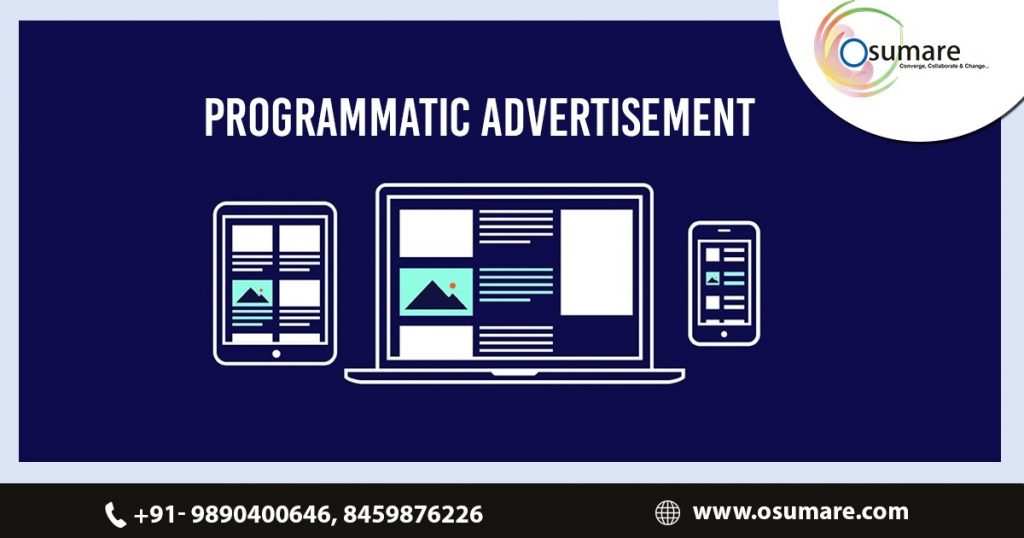
What is Programmatic Advertising?
Successfully capturing the consideration of customers in the present digital ecosystem is no simple task, which is for what reason we’re going to discuss Programmatic Advertising today.
There are a large number of sites, applications and digital properties being seen over a variety of channels, all day, and every day.
Utilizing separate stages to publicize on various channels and choosing the best places to put your notices in the computerized world is an inexorably overwhelming assignment.
Programmatic advertising solves this.
Programmatic advertising is the automated purchasing and selling of online advertising.
This automation makes transactions and increasingly powerful, streamlining the procedure and combining your digital advertising efforts in a single technology platform.
Programmatic platforms have been developing their inventory and database with the end goal that any organization and any channel can be accessed automatically today, including mobile, desktop, tablet, sound, computerized outside and associated TV.
Focusing on strategies are utilized to portion spectators utilizing the information with the goal that sponsors pay for promotions conveyed to the correct individuals at the opportune time, and depend less on the “spray and pray” strategy of digital advertising.
PCs and algorithms make the ad buying, placement and optimization process progressively proficient, expel unremarkable activities and cut down on time to market.
How to use data effectively for programmatic?
Having a comprehension of the behavioural insights of knowledge that can be drawn from information is the initial step to accomplishing an effective programmatic strategy.
There are three levels of information to consider. First-party data is the advertiser’s information on their clients, while second-party data is gathered by somebody other than the sponsor, for example, an office, who offers that information with the brand to help structure the programmatic strategy.
Third-party data is accessible to anybody at an expense and is normally sold on a rate card premise.
Sending existing clients messages about updates or new item offers is known as retargeting.
To develop past that point, he encourages brands to utilize information to discover new prospects, searching for comparable audiences to the current client base.
Programmatic is just an approach to automate ad buying, and RTB is one way this should be possible.
Even though generally 90% of programmatic buying goes on Real-Time Bidding, there are different methods for programmatic advertising, specifically;
•Programmatic Direct:
◦An approach to purchasing an ensured measure of impressions on specific sites.
◦Usually utilized for enormous “premium” groups like full-page takeover ads
◦Often includes a fixed-value agreement as opposed to an auction
Read More: Augmented Reality in Digital Marketing
•Private Exchange Purchasing (PMP):
◦An invitation-only just marketplace where one or a select number of publishers invite specific advertisers to bid on their inventory space.
◦Used as a way of bypassing advertisement trades through and through, where your purchasing stage connects straightforwardly to the publisher’s inventory.
◦An auction usually ordinarily happens, however, the details of the arrangement are pre-arranged, making a more manual condition than normal RTB.
So what precisely is the contrast among RTB and Programmatic?
Constant Bidding is only one piece of the programmatic advertising system.
It’s a method for selling out promotion space on a case-by-case basis as opposed to a carpet-bombing approach where everyone sees a similar advertisement.
For a programmatic system to work properly there should be other key components set up.
On the advertiser’s side, this would be a Demand-Side Platform (DSP), associated with a Data Management Platform (DMP).
Suppliers (distributers) utilize a Supply-Side Platform (SSP) to appropriate their accessible inventory across one or various Ad-Exchanges.
That is a ton of terms to monitor. On the off chance that you continue understanding you’ll discover what they mean!
What is an Ad Exchange?
An Ad Exchange is the place where publishers meet advertisers and concede to a cost to show their advertisements.
It works much like the trading floor of a stock market, however for digital display advertising.
These days most ad exchanges work through continuous real-time auctions, where an ad purchase is set aside the same time as a guest stack a site.
The ad exchange sits amidst the programmatic ecosystem and is connected to a Demand-Side Platform (DSP) on the advertiser’s side and a Supply-Side Platform (SSP) on the publisher’s side.
The ad exchange has a central role in the programmatic advertising framework.
Read More: AI-based Digital Marketing Company in Pune
Difference between an ad network and an ad exchange?
An ad network is a stage that is associated with a specific number of sites, and offers inventory for advertisers on those sites, though an ad exchange is a trading floor where advertisers can purchase advertisement space from numerous advertisement systems.
The ad exchange interfaces with a few ad networks.
Ad exchanges have customarily been utilized as a path for publishers to auction off unsold stock to the most astounding bidder, in the wake of having sold their top-notch stock physically.
You’d toss your remaining space in a pool of other extra space and expectation somebody got it.
The quick development of automatic programmatic ad buying has expanded the significance of ad exchanges since most advertisers have seen the advantages of better focusing on and real-time auctions.
Reach out to Osumare and get our best service. We are the top Search Engine Optimization Company and top digital marketing companies in Pune.
We are the only best Programmatic Advertising Digital Marketing Company in Pune.

